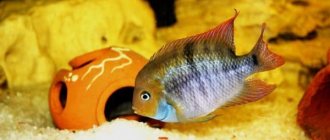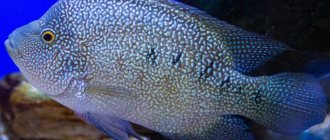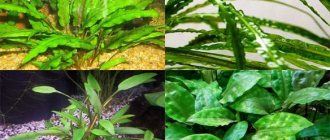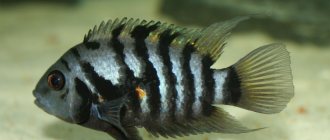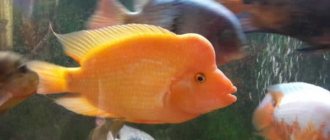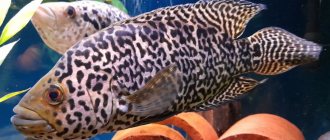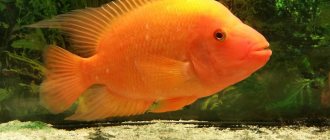Eliot's cichlasoma (Thorichthys ellioti, and previously Cichlasoma ellioti) is a very beautiful fish, with a bright, memorable color and interesting behavior. This is a medium-sized cichlid that grows up to 12 cm in length, and is also quite peaceful in nature. It is these three parameters: beautiful coloring, small size and peaceful disposition that have made Eliot's cichlid so popular in the aquarium hobby.
Description
This is a small fish, the color and shape of the body is somewhat reminiscent of another cichlid - meeka. The body color is gray-brown, with dark stripes along it. There is a black dot in the middle of the body, the belly is bright scarlet, and closer to the tail there is a blue color.
Blue dots are scattered throughout the body, including the gill covers. The fins are large, the dorsal and anal are pointed. Eliot's cichlid grows relative to other cichlids, small, up to 12 cm and can live for about 10 years.
Price
The cost of these cichlids depends on the size, color and age of the fish.
| Size, cm. | Cost, rub. |
| Fry, 1–3 | 170 |
| Grown-up fry, 4–5 | 350 |
| Teens, 6–8 | 600 |
| Young Representatives, 9–11 | 1200 |
| Adults, 12–13 | 1500 |
| Large representatives, 14–15 | 1700 |
Feeding
Omnivores, but be careful when feeding live foods, especially bloodworms, as Eliot's cichlisoma is prone to gluttony and foodborne illnesses.
They happily eat: artemia, coretra, bloodworms, tubifex, daphnia, gammarus. As well as artificial food - flakes, granules, tablets.
You can also add vegetables, pieces of cucumber, zucchini, or food with the addition of spirulina to the diet.
Breeding
The best results for breeding Eliot's cichlosoma are achieved by purchasing a suitable number of fry of different sexes and allowing them to search for a mate at their own discretion. The more options for partners, the greater the chances of a harmonious couple. The optimal purchase quantity is 6-12 individuals. Spawning occurs without human intervention.
The fish become sexually mature at a body length of 6-7 centimeters.
Requirements for the spawning tank
- Once a pair has formed, it is better to keep the fish in the company of other species and individuals, since a pair left alone often develops aggression towards each other.
- There is no need to comply with any special temperature requirements; it should be 24-27°C.
- Periodically check the amount of nitrates in the water.
- Be sure to place rocks or other flat surfaces in your aquarium to facilitate egg laying.
Breeding procedure
- The male will select a suitable territory containing a flat rock or piece of slate (they prefer a smooth, horizontal or slightly sloping piece of aquarium decoration that is in a protected location).
- The female lays here from one hundred to five hundred eggs in small batches. After each batch is laid, the male fertilizes them.
- The eggs should hatch within 3-4 days and the parents will move the fry to a pre-dug hole in the substrate.
- The hatchlings will be free to swim after three to five days, with both parents caring for them to prevent any danger.
- To feed the offspring, use powdered fish food first, followed by small shrimp, gradually moving to larger foods as they grow.
- Parents care for their offspring until the fry reaches a length of 1 to 2 centimeters.
Keeping in an aquarium
Since Eliot's cichlids love to rummage in the ground in search of food, it is important that the aquarium has fine, soft soil, ideally sand. Since the food will be eaten, and they release garbage through the gills, it is necessary that the sand does not have sharp edges.
It is better to use driftwood and large stones as decoration, leaving free space for swimming near the front glass. To create conditions reminiscent of Eliot's cichlids in their native pond, fallen leaves of trees, such as almond or oak, can be placed on the bottom of the aquarium.
Plants can be kept, but in nature they live in places that are not rich in plants, so they can easily do without them. If you want to decorate an aquarium, then choose fairly strong plant species.
Although Eliot's cichlid is not very destructive to plants, it is still a cichlid, and it also loves to burrow in the soil.
It is important to keep the aquarium clean and stable, with low levels of ammonia and nitrates, as at elevated levels they are prone to disease.
To do this, it is necessary to regularly replace part of the water and siphon the bottom, removing leftover food and other debris. A filter, preferably an external one, also wouldn’t hurt.
For a couple of fish, a volume of 100 liters is required, preferably more, since fish are territorial during spawning. Although they will spawn in a small aquarium, all the beauty of their behavior during spawning will be revealed only in a spacious one.
Water parameters for keeping: 24-28 °C, pH: 7.5-8, DH 8-25
Reviews
They respond most often positively, and do not note any great difficulties in the content. Sometimes they write that these cichlids are distinguished by tearing the bottom and raising turbidity.
Compatibility
Although Eliot's cichlids become territorial during spawning, they are not aggressive at all other times. Instead, they have little arguments about who is bigger and more beautiful.
In this way, they again resemble Meek's cichlases; they also like to fluff up their fins and their luxurious throat to show others their beauty and coolness.
If you keep them with other, larger and more assertive cichlids, such as Flowerhorn or Astronotus, then things may end badly for Eliot's cichlids, since they are quite peaceful and not pugnacious.
Therefore, it is better to keep them with the same small or peaceful cichlids: Cichlazoma meeca, Cichlazoma severum, Nicaraguan cichlid, bluish-spotted acara.
But, nevertheless, keeping this cichlid with small fish such as neon or micro-digesting galaxies or glass shrimp means exposing Elitot’s cichlid to temptation.
Some aquarists keep them with swordtails, they scurry around and encourage Eliot to also behave more actively and boldly.
Of the catfish, ancistrus and cockroach are good choices, but it is better to avoid speckled catfish, as they are too small and live in the bottom layer.
The difference between a male and a female
The male and female are similar in appearance, however, it is easy to distinguish the sexes if you come across a pair. The difference is that the male is noticeably larger and has more elongated fin tips. Most females have a dark spot on their dorsal fin, but male fish do not have this spot. The length of the male reaches 12-16 centimeters, and the female – 8-12 centimeters.
External characteristics
The American cichlid is similar to Meek's cichlid, but has its own characteristics. The body of the fish is flattened laterally, shaped like a wide oval. A fin with a dark border stretches along the back, starting almost from the head and reaching the tail. The anal fin starts from the middle of the body and also reaches the tail. Both fins have elongated outer rays, which makes the fish look like an arrow. Cichlazoma has an elongated snout with thick, plump lips and noticeable rounded gills. The eyes are large, black, with colored edging.
The color of cichlazoma is its main advantage. The base color varies from gray-silver to olive. Particularly bright individuals have soft orange shades on the body: lighter on the back and richer towards the lower part. The whole fish shimmers with bright blue sparkles, and there is one black spot on the sides and on the gill covers.
The size of the fish is small - up to 12 cm. Unlike most cichlids, it is suitable for keeping in a relatively small volume. How long fish live in captivity depends on the conditions of detention: with good care, an impressive 12-15 years!
Diseases
Usually fish have good immunity and rarely get sick. However, if you do not maintain favorable water and feeding conditions, you may encounter some problems.
The first and most common problem is the “hole” disease in the head. It appears in the form of pits and depressions on the fish's head. To eliminate the disease, you need to check the nitrate content in the aquarium water.
With an excess of protein foods, Eliot's cichlazoma causes obesity.
Cichlazoma Eliot
Cichlazoma Eliot
Cichlazoma Eliot
If herbalists are not for you, if a riot of colors pleases your eye, Eliot's cichlazomas are your choice! This is an amazingly beautiful and memorable aquarium fish, which, despite its predatory nature, has a calm Nordic character.
Eliot's cichlid is a species of American cichlid of relatively small size. It grows no more than 12-15 centimeters in length.
Its lifespan is no more than 10 years. The color of Eliot's cichlazoma is reddish-brown with many bright blue dots. When a fish swims, its scales seem to be on fire, attracting everyone's attention. Males are slightly larger and brighter than females. Also, females have a black spot on the dorsal fin; in males it is absent or only slightly expressed.
Eliot's cichlazoma habitat
The habitat of Eliot's cichlazoma is located in Central America and Mexico. They prefer ponds with slow currents, where they live in flocks. As a rule, they stay in shallow water near the banks of rivers with a sandy bottom.
Keeping Eliot's cichlases won't be a big deal. Even breeding these fish at home is quite possible for those who are just starting out in the aquarium hobby. The main thing is accuracy and awareness. This is a fairly unpretentious species that can adapt to harsh environmental conditions.
For comfortable keeping of Eliot cichlases, the best option would be to recreate their natural habitat conditions. Light river sand is best suited as a soil. And be prepared for the fish to constantly dig through it. Knowing this feature of fish behavior, you should especially carefully select aquarium soil. The sharp fraction of the soil can damage the delicate gills of cichlases. It is believed that cichlids are not compatible with living plants and, as a rule, cichlids are more like a concrete jungle, however, a small number of live plants with a developed root system in a cichlid can live and thrive. You can also safely use plants that have no roots at all.
When keeping Eliot cichlases, it is very important to remember that for a pair of adult fish there should be at least 100 liters of aquarium volume. If the fish feel constrained, conflicts will be inevitable. The urge to fight for living space is in the blood of all cichlids and nothing can be done about it.
Cichlazoma Eliot photo
The pH of American cichlid water must be maintained in the range of 7.5 - 8. The optimal water temperature is 26 - 28 degrees. You cannot do without an automatic aquarium heater. The fish is undemanding when it comes to aquarium lighting; on the contrary, it prefers shade. Excessive lighting can cause stress. Aeration is necessary, as in any other. The aquarium's filtration must be strong enough to cope with the cloudiness of the water caused by the digging of the fish and their PJ. It is better to use an external filter.
As for compatibility, Eliot's cichlazomas can be kept in a community aquarium. They show almost no aggression towards fish of comparable sizes, excluding fish with veil fins and tails. They also get along with almost all types of catfish. Problems with keeping can only be associated with the aggression of the fish during spawning; the rest of the time the fish are peaceful.
If, while working on the design of an aquarium, you abandoned a natural reservoir in favor of sunken ships and cities, Eliot's cichlids will fit perfectly into this gray landscape, giving it fire and solemnity.
They are also unpretentious in food. Eats bloodworms, tubifex, daphnia, hamarus, and brine shrimp. You can feed artificial food in the form of tablets, flakes or granules. Some aquarists add vegetables to the menu of their cichloses: cucumber, zucchini, lettuce or spinach. It should be remembered that aquarium fish should not be overfed. This is especially true for cichlases. Despite its omnivorous nature, the fish is greedy and prone to gluttony.
Feeding aquarium fish should be correct: balanced, varied. This fundamental rule is the key to the successful keeping of any fish, be it guppies or astronotuses. The article “How and how much to feed aquarium fish” talks about this in detail; it outlines the basic principles of the diet and feeding regime of the fish.
In this article, we note the most important thing - feeding fish should not be monotonous; the diet should include both dry food and live food. In addition, you need to take into account the gastronomic preferences of a particular fish and, depending on this, include in its diet food either with the highest protein content or, conversely, with plant ingredients.
Popular and popular food for fish, of course, is dry food. For example, you can constantly and everywhere find food on aquarium shelves - the leader of the Russian market; in fact, the range of food for this Tetra is included as individual food for a specific type of fish: for goldfish, for cichlids, for loricariids, guppies, labyrinths, arowanas, discus, etc. .d. Tetra has also developed specialized foods, for example, to enhance color, fortified, or for feeding fry. You can find out detailed information about all Tetra feeds on the company’s official website - here .
Cichlazoma Eliot
Cichlids attract people with their character, habits and beauty. These are predators, but keeping them is no more difficult than small peaceful fish, and much more interesting. One of the most popular cichlids in home aquariums is the Eliot cichlid. The combination of its small size, bright color, unpretentiousness and that famous “predatory character” brought it popularity.
How to determine gender
Typically, Eliot's cichlazomas, ready to reproduce, choose a mate and stay together. Sexual maturity occurs at approximately one year of age. Sexual differences are weakly noticeable: the female is somewhat paler and smaller, the male has a more contrasting color.
Experts recommend immediately buying 8-10 cichlazoma fry, raising them together, and removing fish that have not found a mate. Therefore, when choosing fish to place in a spawning tank, there should be no mistake: if a pair has formed, this is clearly visible.
What to feed Eliot's cichlid
The basis of the diet is food of plant origin. The best solution is special dry mixtures for cichlids. You need to choose food from good producers. A cheap one leaves a lot of dirt, and in sandy bottom conditions it is especially difficult to deal with it.
Feeding with live food should also be present, but in smaller volumes. To the main food you can add bloodworms (live, frozen), shrimp and pollock fillets, and add small live fish. This is necessary to satisfy the need for hunting. But if doing this is morally difficult, then it is not necessary.

